#these are the keeper poults for this year
Explore tagged Tumblr posts
Text

The crew's out and about.

And then there's this guy, who isn't as personable.

Very pretty chocolate tricolor, though. <3
3 notes
·
View notes
Video
tumblr
I’ve already written about the basics of animal training a handful of times on this blog, and one of those times, I explained the process of training targeting behaviour in young turkey hens. To recap, targeting is when an animal learns to touch a specific body part to a certain location or object. Birds are typically trained to touch their beak to a “target” stick. I do this regularly with the raptors I work with, and my own pet chickens picked it up quickly as well. I wanted to see if the turkey poults that were part of my research project last summer could learn it too, and they did! Now, as a way to take my mind off the stress of first year vet med school final exams, I thought I’d train my button quail hen, Kiwi, to target. And guess what? She picked up the basic mechanism of it within just one day.
As for all the other species I’ve trained, I started by teaching Kiwi to respond to a bridge - the clicking sound I make with my mouth. A bridge doesn’t have to come from a fancy clicker, nor does it have to be a click at all. It just has to be any stimulus that is clear to the animal, and that you can produce quickly and consistently - a whistle, verbal praise, etc. will do just fine - animals who are hard of hearing or otherwise can also be taught to respond to a wave, or touch signals.
Next, I had to shape the targeting behaviour by using successive approximations. This is animal trainer gobbledygook for: start simple, then work your way up. I would reinforce any attempt to peck any part of the stick at first. Then, I would only reinforce pecks that were aimed at the circular end of the stick. Once that was down, Kiwi was eager to follow the stick/me around her living space, and peck it for some chonky mealworms. The stick was not scented/baited in any way - she really did learn to target to it for a reward. Many zoos will do this with their animals as an enriching activity, or to make both the zookeepers and animals’ lives a bit easier - for example, instead of having to stressfully chase and then shove an animal into a crate/holding area when their enclosure needs to be cleaned, keepers can simply target the animal into the crate, and clean away while it enjoys a reward. I’ll repeat what I say over and over again on this blog: giving animals under human care some control over their environment by giving them a choice to actively engage in activities like this is critically important for their emotional and psychological health.
With that, the plan was to build a tiny little obstacle course for Kiwi and to use the target stick to get her to learn to run through it. Things have come to a grinding halt though, as I’ve been letting her keep the eggs she lays, and she actually went broody a couple of weeks ago! They are due to hatch TODAY or tomorrow, and you best believe I’ll be spamming this blog with all the button quail chicks as soon as it happens <3
#quail#buttonquail#animal training#animal trainer#animal behavior#birds#target training#original post#Excalfactoria
440 notes
·
View notes
Photo
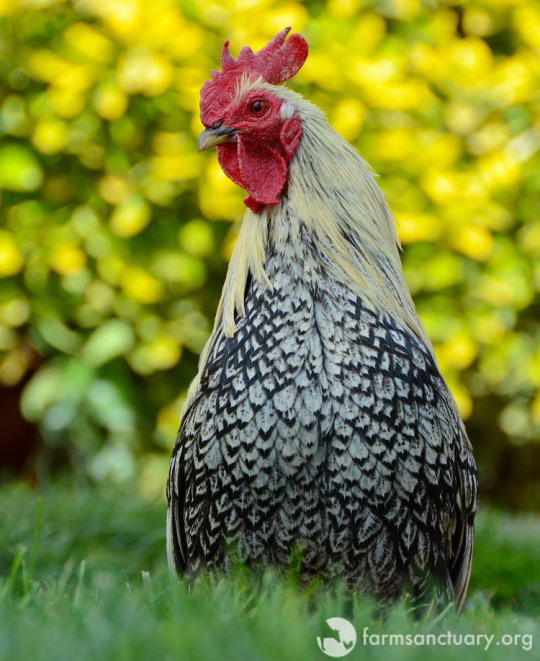
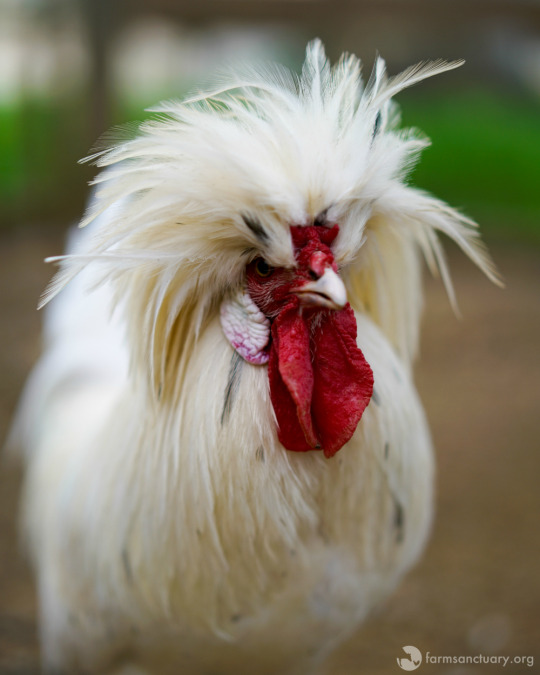
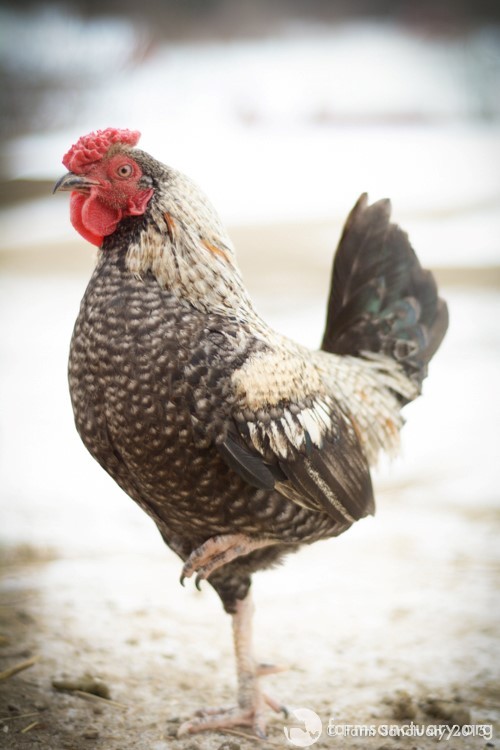
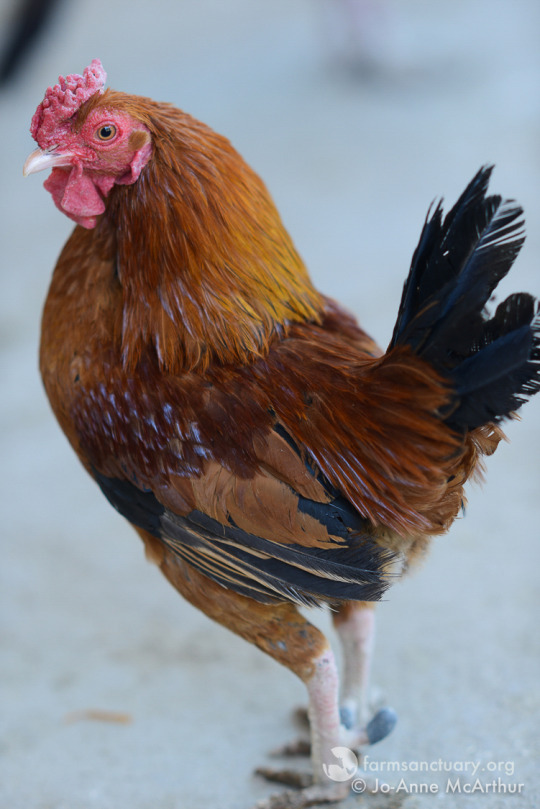
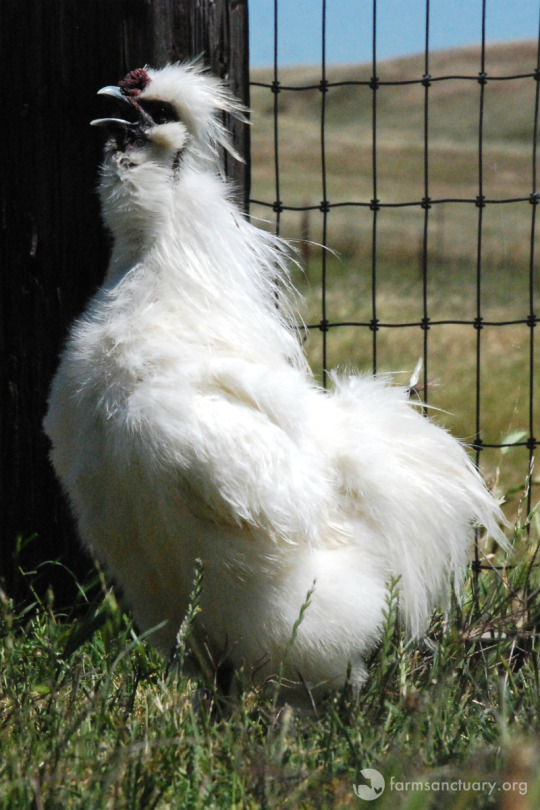
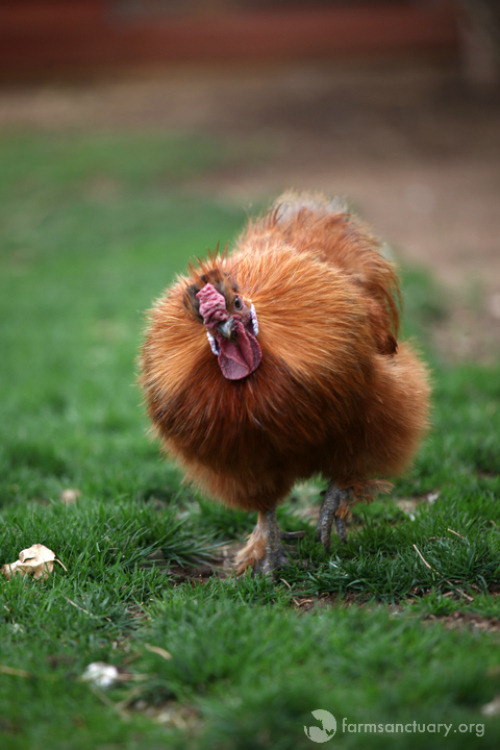
Happy Year of the Rooster!
It’s Chinese New Year — and this year, we’ve all got something to crow about! This is the Year of the Rooster — a time to honor our feathered friends and all we can learn from them.
Chinese New Year offers a wonderful opportunity to make new beginnings, celebrate the individuals and experiences that are important to us, and value the ways in which we may grow when we empathize with those around us. Whether or not you were born in the Year of the Rooster, there is so much that we can all learn from these often-misunderstood animals, and so many positive qualities that we can appreciate in them and emulate in our own lives.
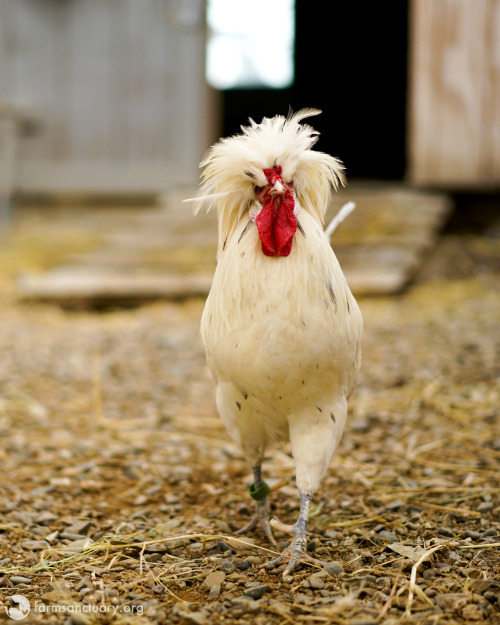
Rod Stewart is known for his dancing skills!
According to the Chinese zodiac, people born in the Year of the Rooster are loyal, outgoing, dedicated, and beautiful – and these qualities extend to our galline counterparts, who can inspire us to take charge of our lives and deepen our sense of self-worth. Roosters feel that it is important to be heard — and thanks to support from friends like you, we can tell the world how magnificent they truly are when we take the time to listen.
Sadly, roosters often don’t get the credit — or respect — they deserve. They often find themselves cast aside by humans — viewed as nuisances, or unwanted because, unlike their female counterparts, they can’t lay eggs.
In fact, we receive more calls asking for help rehoming roosters than any other placement request — at least one inquiry each and every day. And unfortunately, there are more roosters in need than there are homes for them.
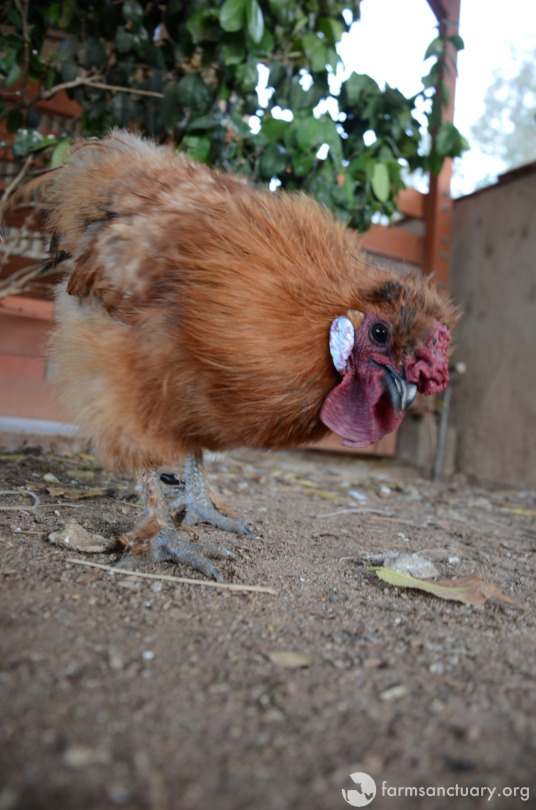
Feisty, charming Li Mu Bai exploring at our Southern California Shelter.
But you can be a compassionate voice for roosters this year by helping to spread the word that every one of them is someone, not something. When people take the time to get to know roosters as individuals, they can come to admire their bold confidence, protective nature, and proud individuality.
Unfortunately, many roosters’ lives follow one of two tragic trajectories: being raised for meat, or born into and discarded by the egg industry (depending upon his breed). In either case, he is denied the chance to grow up and enjoy the rich, fulfilling life he has the potential to lead. When granted the freedom to live life on their own terms, however, it is inspiring to watch roosters confidently greet each day as the beautiful gift it is. Their admirable spirit is something we can all embrace as we welcome the Year of the Rooster!
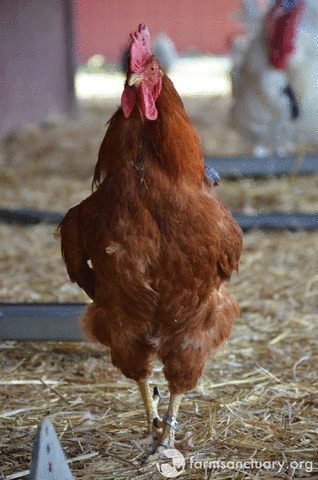
Handsome Luther always makes his voice heard.
Roosters love to be seen, heard, and admired, but sadly, most of them live their lives without ever really being seen at all.
Cornish-breed chickens, called “broilers” in the industry, make up the vast majority of all farm animals who are raised and slaughtered for food; the meat industry sends 8.8 billion chickens to slaughter annually in the U.S. alone. Typically raised on factory farms, these birds are locked away from public view — meaning that the average person never sees the deplorable ways in which they are treated.
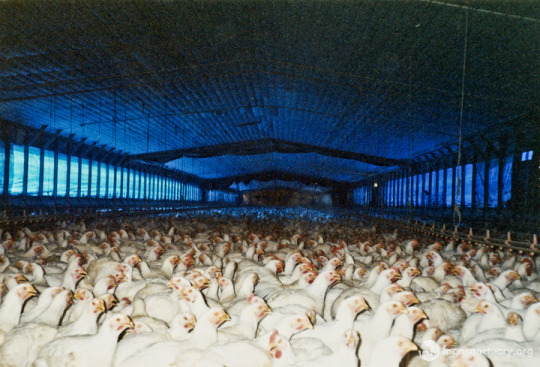
So-called “broiler” chickens on a factory farm.
These animals are selectively bred and fed to grow at alarming rates, reaching their “slaughter weight” of about five to six pounds in just 42 days. Shockingly, these terrified, fragile beings are still peeping like the babies they are at the time they are sent to slaughter. Instead of finding safety and comfort under their mothers’ wings, they are crammed into filthy, warehouse-like buildings among thousands of other birds. Many experience ailments including heart and lung problems, and their legs and bodies break down from their unnaturally massive size.

The dashing Mo Justice.
For most roosters who are killed for food, life will end at an industrial slaughter facility. But others find themselves at live markets — businesses where customers may pick out a live animal who is then slaughtered onsite. Our friend Mo Justice, now a resident of our New York Shelter, likely escaped from one of New York City’s many live markets. But unlike the countless roosters who meet their end at these facilities, this resourceful boy escaped and now serves as an ambassador for others just like him.
In late 2015, Sgt. Anthony Egan was patrolling a Brooklyn neighborhood when he spotted Mo Justice, alone and in distress. Mo was ill, weak, and on the verge of death. Sgt. Egan’s heart went out to him and was determined to help.

A proud Sgt. Egan with his rescued pal.
Thanks to a team of compassionate friends, Mo was able to make his way to Farm Sanctuary. Here, Mo has recovered — and blossomed. He carefully watches out for the ladies in his new flock, and they are quite taken with their handsome suitor!
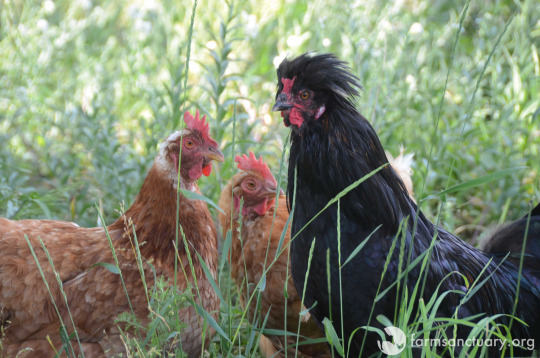
Mo with his lady friends.
As consumers become more aware of the harsh realities of the meat, egg, and dairy industries, many have begun to seek out animal products that come from smaller farms that are presented as “humane” alternatives. They hope that the animals on these farms enjoy a greater quality of life and care, with more space and a higher level of individualized attention. Unfortunately, these ideals are often far from the truth — we’ve witnessed all too many cases of cruelty, neglect, and lack of care on such farms. And even in the best-case scenario, where animals are raised according to the most “humane” standards, there is nothing humane about killing an individual who wants to live.
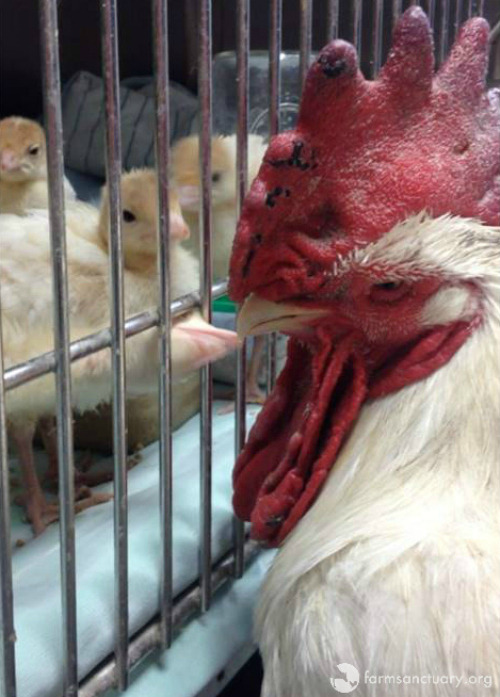
Baba Ghanoush rooster visiting with new friends: young turkey poults!
Present-day agriculture has industrialized reproduction and child-rearing — perhaps the most natural processes on earth. Roosters, when allowed to live life on their own terms, are fiercely protective of their hens and do everything in their power to keep their flock safe, and hens establish relationships with their chicks even before they hatch. But sadly, most chickens — hens and roosters alike — are prevented from experiencing these natural bonds, and are instead separated from the individuals they would hold dear if they had the chance.
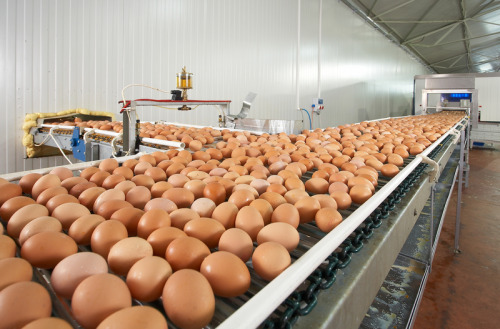
Today, no matter where they end up, nearly all chicks begin their lives in hatcheries. Eggs are artificially incubated and hatched; chicks never get to experience the warmth of their mothers’ bodies.
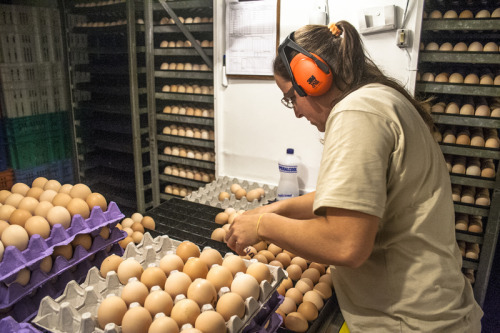
In the egg industry, female chicks are wanted; males are not. While still just fragile babies, chicks are sorted by sex — and it is at this point that most layer-breed roosters’ lives end before they truly begin.

Since roosters cannot lay eggs, they are considered useless by the egg industry. And because birds from egg-laying breeds do not grow as large as the Cornish birds who are typically used in the meat industry, meat producers wouldn’t want to take on the egg industry’s unwanted male chicks because raising them wouldn’t make sense for their bottom line. Therefore, these male babies are typically treated no better than trash, ground up in macerators while fully conscious, placed against electrified “kill plates,” or gassed.
But since the process of sexing chicks is often quick and inaccurate, some young roosters are mistaken for females and thus avoid this fate. Such was the case for Judd and Jackson, who are likely Miller’s Champion Brown Leghorns, a type of chicken that is bred to produce large quantities of eggs. Treated the same way as the hens they had been mistaken for, they were debeaked in preparation for a brief life of confinement, in an effort to prevent them from harming other birds out of frustration.
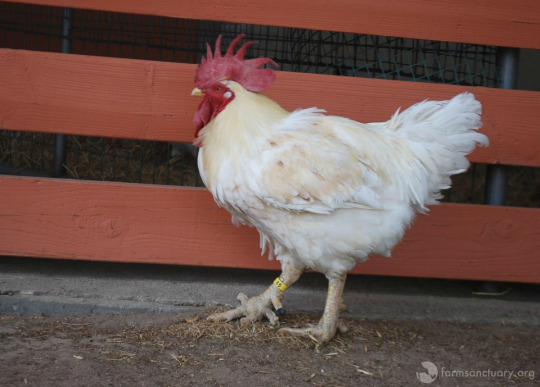
Judd exploring at our Southern California Shelter.
Eventually, however, their true identities were discovered. Considered to be of no further use since they couldn’t lay eggs, the boys were packed in tightly among thousands of “spent” hens who were sent to be slaughtered as part of a religious ceremony. But luck was on Judd and Jackson’s side once again, when they were rescued by activists and brought to Farm Sanctuary. Today, they serve as ambassadors for the countless males who sadly do not make it out of the egg industry alive.
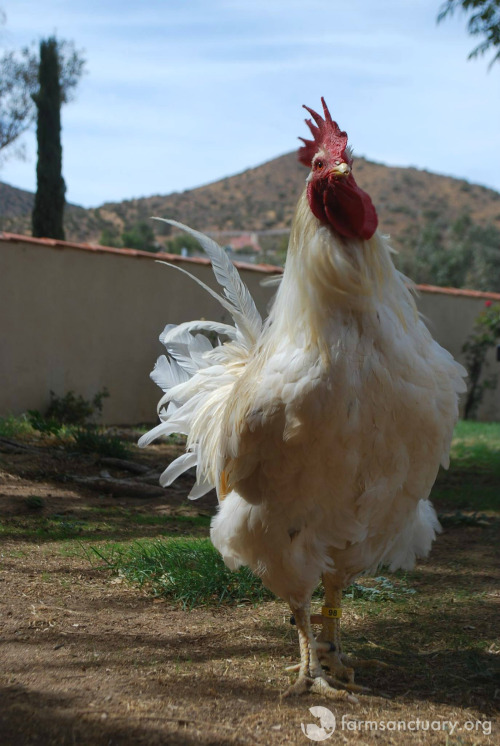
Jackson enjoying a nice day in the courtyard.
It’s clear that roosters born into the world of industrial meat and egg production are treated inhumanely. But what about the birds who reside in more “humane” homes, such as backyard hobby flocks? While their circumstances may appear brighter, their lives typically begin in a similar way to their brothers who are raised for meat on factory farms or born into the egg industry.
Most chicks sold to backyard hobbyists are born in hatcheries and are shipped through the mail, either directly to buyers or to places such as feed stores that then resell them to the public. Baby birds shipped through the mail may travel without food, water, and protection for days at a time. And since backyard flock keepers typically want hens who will lay eggs, males are often unwanted in these situations as well. In many cases, male chicks who are inaccurately sexed are sold as females to unsuspecting buyers, who have a rude awakening when they later discover that one or more of their “hens” is actually male. In other cases, male chicks are purposely included to serve as “packing material” for the more financially valuable females before they, too, are discarded. Many, sadly, do not even survive the journey.
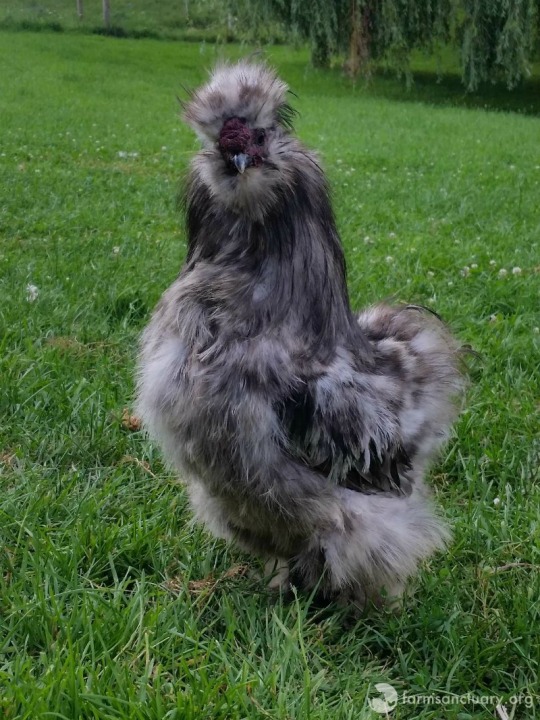
Weechee and his best rooster pal Widdle were sold to their former guardian with the assurance that they were female. Fortunately, we were able to take them in at our New York Shelter. These pranksters delight us with their vibrant personalities and always keep us on our toes.
Even the most well-intentioned hobbyists, who want only the best for the birds in their care, can be faced with a difficult dilemma if a flock member turns out to be a rooster. Many municipalities forbid residents from keeping roosters, leaving their guardians with little choice but to get rid of them. Sadly, many roosters in this situation end up abandoned or killed — some wind up in shelters, where euthanasia rates are high, while others are killed by predators or die because they are unable to adequately fend for themselves.
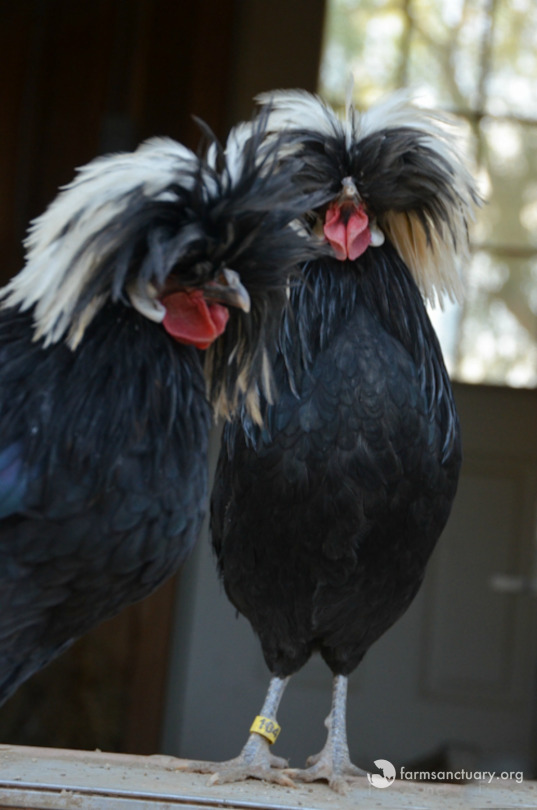
King and Stephen draw plenty of attention from sanctuary visitors, who are enamored by their rock-star “hairdos” and even bigger rock-star personalities!
The story of Stephen and King, named for the author, could have ended in horror — but instead, they are enjoying their happily-ever-afters at Farm Sanctuary’s Southern California Shelter. One morning, we found the brothers and four other fancy-breed roosters in a cardboard box at our shelter gate. While we can’t know their exact origin, the logical assumption is that they were sold as females to a guardian who either didn’t want or was prohibited from keeping roosters.
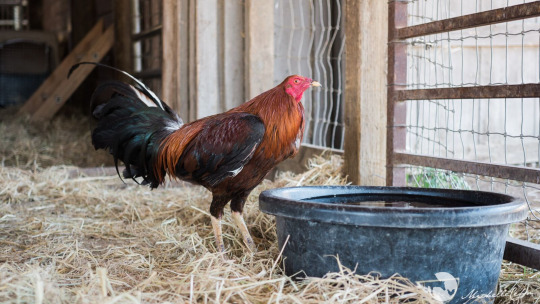
Hansel survived the cruelty of cockfighting.
Some roosters find themselves in need despite having well-meaning guardians. But others are raised by people who treat them cruelly on purpose. Farm Sanctuary residents Derek Zoolander and Hansel came to us after a cockfighting bust and now inspire us with their ability to move beyond the trauma in their past. While both bear physical scars from their cockfighting days — they are missing the majority of their combs and wattles, removed by their former “owners” — they now have the chance to live their lives in peace. In their case, because they were not able to live with each other or other birds, they have each found companionship with friends from other species!
youtube
Derek Zoolander’s story.
These days, Derek enjoys living and protecting his new goat friends Marcia and Maurice, while Hansel feels at home with pals Timi, Mason, and Topanga sheep and Clarke and Kent goats. The boys love chaperoning their new interspecies flocks, and we are thrilled that they are finally free to be the protective, loving boys they long had the potential to be!
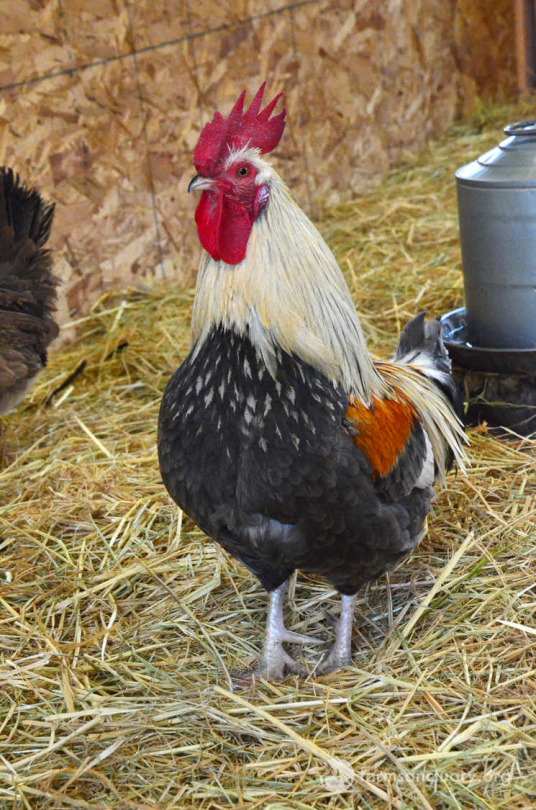
Bean always has the best interests of his flock at heart.
Roosters are very protective; for some, like Derek Zoolander and Hansel, that means looking out for goats and sheep, but a more common living arrangement sees roosters protecting the lady friends in their flocks.

The ever-vigilant Milo Gibson.
Farm Sanctuary residents Bean and Milo Gibson — who live at our Northern California and New York shelters, respectively — are always looking out for their girls and give loud warning squawks when they spy anything that looks amiss. Both boys are very chivalrous and treat their girls with care and respect. During mealtimes, for example, Milo alerts the girls and lets them feast first before joining in himself. And Bean has an adorable habit of holding treats, such as cranberries and grapes, in his beak for his hen friends to take and enjoy. When given the opportunity, roosters will do everything in their power to keep their hens happy, healthy, and safe. Their loyalty and spunk is much to be admired — and at Farm Sanctuary, we are happy to witness manifestations of this love each day.
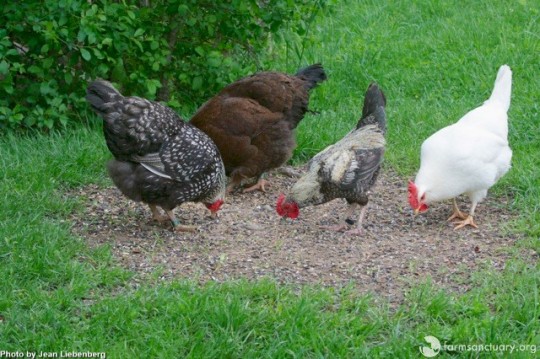
Milo and his ladies.
Despite all the difficulties that roosters face — no matter the industry they’re born into — it’s incredible to discover just how unique, relatable, and inspiring they truly are. We can learn so much from these special birds (and honor the “roosters” in ourselves) when we put compassion first.
If you’re interested in welcoming a rooster into your home and heart — and have the time, ability, resources, and rooster-friendly zoning necessary to properly care for one — please consider becoming a member of our Farm Animal Adoption Network. For those who aren’t prepared to adopt a rooster, it’s easy and fun to support a feathered friend from afar through our Adopt a Farm Animal Program.
Please join us as we welcome the Year of the Rooster and celebrate the incredible qualities that these very special birds possess. With your support, we may usher in a new year for roosters and all farm animals — and we are incredibly thankful for your support in making their new lives at sanctuary possible. Together, we can continue to promote compassionate vegan living through rescue, education, and advocacy efforts. A compassionate world — and year — begins with you!
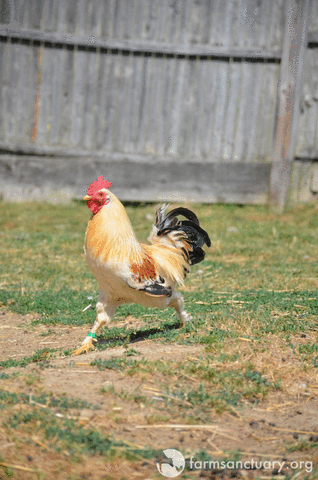
33 notes
·
View notes
Text
Keeping Turkeys Healthy in Winter
By Don Schrider – Turkeys are remarkably hardy birds. By the time turkeys reach maturity, they are very easy to care for, and are capable of surviving winter weather in great shape. When you venture into keeping turkeys, you will discover a large range of beautiful colors to be found in turkey breeds—red, white, bronze, blue, and even complex patterns with combinations of several colors. Whether you decide on a Royal Palm Turkey or a Bourbon Red turkey, who wouldn’t enjoy having a tom strutting around displaying his brilliant tail feathers? They are inquisitive, impressive, and intelligent, it is a wonder more people do decide on keeping turkeys part of their backyard flock.
When keeping turkeys, the nature of turkeys is the first consideration we should take into account when planning on caring for turkeys through the winter. Turkeys are inquisitive and may easily become bored when confined to small pens. They like to range, and this exercise helps to keep muscles toned, generates body heat, and increases appetite. They like to roost at night, which provides them with protection from predators. While roosting, they will huddle together, thus keeping each other warm. For a roost location, they naturally seek out a location with fresh, moving air—this provides plenty of oxygen, whisks away moisture, and prevents ammonia from manure from damaging lung tissue. They need a supply of fresh feed and water to remain healthy.
Biggest Winter Challenge is Access to Fresh Water
Providing unfrozen water may be the biggest challenge in keeping turkeys in the winter. As turkeys exhale a good deal of moisture is lost. This is largely due to the anatomy of turkeys. Unlike mammals that have sweat glands, turkeys are designed to use the breath to cool the bird during hot periods by giving off moisture. Turkeys are large birds and so need a fair amount to drink just to digest their food as well. Buckets can be used as waterers in areas that freeze. I suggest emptying the buckets at night and filling again in the morning. If possible, watering a second time in the afternoon is advisable. Buckets can be turned upside down in the sun and usually will thaw enough for the ice to slip out. Buckets can also be brought into a warm location, such as a cellar, and allowed to thaw enough to empty. If your turkeys are penned near a location with electricity, which is also covered from the weather, a heater can be used to prevent their drinking water from freezing. If a fresh moving stream is to be the water source, keep in mind that during low temperatures the turkeys can suffer frostbite to their wet toes and feet. My grandfather had a duck whose feet actually froze in this way.
Housing Needs of Turkeys
The types of pens used to contain the turkeys must be taken into consideration when keeping turkeys in the winter. Turkeys on range will naturally exercise, burn a lot of calories, and eat to support their activity level; leaving them better able to withstand winter winds and temperatures. Smaller pens do not provide turkeys with opportunities to exercise, and so must do a good job of protecting turkeys from the elements. Pens should be so designed to block prevailing winds but allow for plenty of air movement. Turkeys can stand the full force of the wind better than a draft. So take the time to feel for air movement in the area of the roost. Cold, wintry rains can chill turkeys; turkeys should have access to covered areas—even if they choose not to use them.
Turkeys are independent thinkers and have their own idea of what is best for them. Many turkey keepers find their turkeys refusing even a roof and roosting on top of fences or in trees during the worst of New England winters. Our job is not so much to control the turkeys but to provide them with shelter they can choose to use and to design pens to support their natural health and well-being.
Roosts should be made of 2 x 4 boards turned so that they are 2″ high and 4″ across. Setting the roost boards in this way ensures that the turkeys have plenty of support for their breastbones and ensures that their feet are covered and kept warm as they sleep — preventing frostbite to toes.
Turkeys can also suffer frostbite to their faces and snoods. But in most cases, turkeys that choose to sleep in the open will tuck their heads under one wing during extreme cold or weather. Turkeys in pens are more prone to frostbite of the face and snood due to lower exercise level—which causes the circulatory system to run slower than when exercising—and to increased moisture in the air. Frostbite of the face and snood is much more likely when the moisture whisks away body heat faster, just like water does to hypothermia victims.
We often think of keeping turkeys and other poultry warm in winter. But what we really need to do is keep the air fresh and moving, preventing both ammonia and moisture buildup, and give them ample opportunity to exercise. If we provide plenty of fresh food and unfrozen water to drink, the turkeys will fair quite well despite cold temperatures.
Winter Feed for Turkeys
Use caution with fresh water sources for your poultry. Turkeys can freeze feet, toes, faces and even their snood when continually wet. Photo courtesy of Linda Knepp, Nebraska
While we are talking about food, winter feeding of turkeys differs little from feeding at other times of the year. We still want to provide a good, base turkey feed—available free choice so that turkeys may consume as much as they like. In addition, I suggest a late day feeding of corn, wheat, or both. Corn adds calories and fat to the diet and gives the turkeys something to burn to keep them warm at night. Wheat generates a lot of heat as it is digested, and so is an excellent winter feed. It also contains a fair amount of oil, so it helps keep feathers in good condition. Feeding these grains late in the day causes the turkeys to eat a little bit more before they go to roost at night, ensuring a full crop for the long winter night. It also helps in two other ways: it causes the turkeys to exercise as they search out the grains, and it gives them something to do to alleviate boredom.
Early Breeding
Keeping turkeys can begin with hatching poults. If you wish to hatch turkey poults early in the year, light stimulation can bring turkey hens into egg production and give toms a desire to mate. Light stimulates hormone production, and thus brings about the onset of breeding. We find light levels are necessary in some chicken breeds before roosters will breed. Wyandottes are a good example—they have little interest in the hens until spring approaches. Just as in chickens, turkeys need about 14 hours of daylight. It is best to add artificial light to the beginning of the day rather than the end, to ensure that the turkeys can see to roost. Talk about getting up with the birds!
You can expect to see egg production begin about four weeks after lights have been used to extend day length. If temperatures are still low, be sure to collect eggs frequently to prevent chilling or freezing. Eggs that freeze and crack are no good for setting and should be discarded such that the turkeys do not learn to eat the contents and begin egg eating. Store eggs for hatching in your home in a location with a constant temperature and humidity. Save them for up to two weeks—hatchability will be best on eggs saved for two weeks or less.
Added Energy Boost Through Diet
If your turkeys seem a bit lethargic or rundown during winter, they may simply need a boost to their diets. Old timers used to give the turkeys some meat at such times. In fact, some old timers would butcher a hog and give the turkeys the whole carcass. One old timer asked me, “Why do you think the heads of turkeys are bare like a buzzard?” Of course, this was in very large flocks. While it may be unpleasant to give your turkey flock a dead animal to consume, there are alternatives. You can simply give the birds a little bit of ground beef. The protein and the amino acids in raw meat will help the turkeys satisfy what is lacking in their feed. Remember, turkeys need high levels of protein in their diets—in winter they cannot supplement for themselves with insects or other natural forage.
Keeping turkeys healthy in the winter is remarkably easy. The turkeys will reward you with their playful antics, their friendliness, and their beauty. Try these “birds of a different feather” for yourself, I am sure you will find them a great addition to your flock.
Text © Don Schrider, 2012. All rights reserved.
Don Schrider is a nationally recognized poultry breeder and expert. He has written for publications such as Backyard Poultry, Countryside and Small Stock Journal, Mother Earth News, Poultry Press, and the newsletter and poultry resources of the American Livestock Breeds Conservancy.
He is the author of a revised edition of Storey’s Guide to Raising Turkeys, which will be available by January 2013. Please see page 67 for the book review, and page 69 to order your copy.
Originally published in Backyard Poultry December 2012 / January 2013
Keeping Turkeys Healthy in Winter was originally posted by All About Chickens
0 notes
Text
Broad-breasted Vs. Heritage Turkeys for Thanksgiving
Though frozen turkeys reside in your grocery store all year, they become the main attraction during the final two months. Many like the idea of heritage turkeys for Thanksgiving. But this also promotes questions: What is a heritage turkey? Where can I find a bird raised without added hormones? Why is antibiotic-free important? And why is there such a huge price difference between standard and heritage?
The Noble Turkey
A completely Western breed, the turkey originated within the forests of North America. They belong to the same bird family which includes pheasants, partridge, jungle fowl, and grouse. When Europeans first encountered turkeys in the New World, they incorrectly identified them as guinea fowl, a group of birds believed to originate in the country Turkey. The name of this new North American breed then became turkey fowl, which was soon shortened to turkey. The name took hold further as Europeans brought them back to breed in the Ottoman Empire, also known as the Turkish Empire or Ottoman Turkey. The bird gained popularity so early that William Shakespeare referred to them in the play Twelfth Night.
Japanese Beetles? Ticks? Bugs? Guinea Fowl might be the answer!
This FREE guide describes this fascinating bird and how to raise them. Discover if guineas are right for you. YES! I want this Free Report »
Turkeys have been domesticated in Mesoamerica for more than 2,000 years. Males are referred to as toms (stags in Europe), females are hens, and the chicks are called poults or turkeylings.
Incredibly social breeds, turkeys can die of loneliness if they aren’t kept with acceptable companions. Farmers have stories of toms that fluff and strut when human women walk past the coop or of hens that follow their humans around during mating season. Turkeys are also vigilant and vocal, chirping as young birds and gobbling as adults in response to loud noises. As with all fowl, males can be territorial and even violent, attacking intruders or newcomers with sharp claws.
Jennifer Amodt-Hammond’s broad-breasted bronze tom.
Broad-Breasted Turkeys
Unless the label states differently, most industrially raised turkeys are broad-breasted. They grow quicker and dress out heavier than heritage counterparts.
Two types of broad-breasted turkeys exist: white and bronze/brown. Though we see stunning pictures of iridescent bronze turkeys with white banding, the most common color for commercial production is white because the carcass dresses out cleaner. Bronze pin feathers can be dark and visible. Often, a melanin-rich pocket of fluid surrounds the feather shaft, leaking like ink when the feather is plucked. Growing white birds eliminates this problem.
If you purchase turkey poults from a feed store and want to start a breeding project, first verify the breed. Mature birds cannot be used for breeding unless the farm has special equipment and training. This is because the breasts are so large that these birds cannot mate naturally and must be artificially inseminated. Most commercial turkey farms purchase poults from hatcheries, raise them within a season or two, process, and purchase again.
Labels may say, “young tom” or “young turkey.” Most commercial growers process their birds at seven to twenty pounds and freeze them until the holiday season. This is because a broad-breasted that is allowed to grow to maturity can dress out at over fifty pounds. More than 70% of that weight is within the breast. If they grow too fast or too large, they can injure joints, break legs, or have cardiac and respiratory problems. Poultry keepers who are new to turkeys soon learn this. After cutting their birds with band saws so they can fit in ovens, or processing on an unplanned weekend because the turkey has gone lame, the farmers decide to butcher within July or August if they do it again.
A Narragansett heritage breed tom at the National Heirloom Expo
Heritage Breeds
Unlike broad-breasted varieties, heritage turkey breeds can mate and fly in the same ways as their wild ancestors. They are smaller, rarely dressing out above thirty pounds, and must be kept with better fencing because they can escape and roost in trees. Because they haven’t been bred with the focus of producing a lot of meat within a short period of time, they grow slower and therefore can live for years without health problems. Food critics claim heritage breeds taste better and have healthier meat than their industrial counterparts.
Commercially, heritage breeds compose a small percentage, around 25,000 produced annually compared to 200,000,000 industrial (broad-breasted) birds. This has increased from the end of the 20th century when the broad-breasted white had become so popular that heritage breeds were almost extinct. In 1997, The Livestock Conservancy considered heritage turkeys the most critically endangered of all domestic animals, finding fewer than 1,500 total breeding birds in the United States. Along with Slow Food USA, the Heritage Turkey Foundation, and small-scale farmers, The Livestock Conservancy hit the media with advocacy. By 2003 the numbers had grown 200% and by 2006 the Conservancy reported that more than 8,800 breeding birds existed in the United States. The best ways to help the heritage populations are to join in the advocacy, to raise heritage turkeys if you have the farming space, and to purchase heritage turkeys for your meals if you cannot raise them.
Heritage turkeys are among the most stunning livestock around. The Spanish were the first Europeans to bring turkeys back, resulting in breeds such as Spanish Black and Royal Palm. Bourbon Reds originated in Bourbon, Kentucky, from crossing Buff, Standard Bronze, and Holland White. The beautiful Chocolate Turkey has been raised since before the Civil War. Excellent choices for smaller farms and families include the Midget White and Beltsville Small White. Competing in for the title of “eye candy” are Blue Slates and Narragansetts.
Photo by Shelley DeDauw
The Price Divide
Why do heritage turkeys for Thanksgiving cost more per pound than standard birds? Mostly because of the nature of the bird.
Farmers who have raised chickens for meat have probably acknowledged that a Cornish Cross dresses out within six weeks while a Rhode Island Red is ready within four to six months. All that growth time equals money spent on feed and the Cornish Cross produces much more meat. Though the meat variety eats more per day than the dual purpose breed, the total feed to meat ratio is much lower. The same principle applies to heritage breeds. In addition to growing slower, a heritage turkey is also more active, which results in less fat.
A secondary factor to price is how turkeys are raised. Large-scale farming operations pack in birds that can thrive in such confined quarters, allowing more production for the space. Heritage breeds don’t fare as well in small spaces. Consumers who purchase heritage turkeys also tend to hold a higher standard to their meat, eschewing additives or antibiotics, which can extend the life of a bird raised in confinement. They want birds that have been raised naturally and humanely. That means packing fewer birds into a larger area, resulting in less profit per acre. Learn more about pastured turkeys from Acres USA.
Buying the best turkey requires understanding labels
Antibiotics and Raising Turkeys
Keeping turkeys can require more care than keeping other poultry. They can contract many diseases such as blackhead, avian influenza, aspergillosis, and coryza. Because biosecurity is so crucial in a bird that can get so sick, many growers resort to adding antibiotics to daily feed. Others manage biosecurity by maintaining a clean and completely secure farm, refusing to allow visitors and keeping turkeys in comfortable barns to keep wild birds away from the flock’s food and water supply. Organic turkey farms use neither antibiotics nor feed that has not been certified organic.
Turkeys may start out antibiotic-free, but farmers may medicate an entire flock if a few birds get sick. Some growers keep separate flocks, raising turkeys without antibiotics until problems occur then moving sick birds to another pen if they have to medicate. Others must euthanize sick birds to keep the rest of the flock safe.
An ongoing argument exists regarding the ethics of using antibiotics. While many farmers have announced that they will stop adding medication to daily feed, they hold that treating sick animals is the most humane way to raise meat. Eschewing all antibiotics means suffering of the animal, spread of disease, and euthanasia of sick animals before the other livestock can contract the illness.
No matter which method the farmer chooses, all reflect in final purchasing prices in heritage turkeys for Thanksgiving. Meat from a farmer who feeds antibiotics daily will probably be less expensive because it results in fewer veterinary visits, lower labor costs, and fewer dead birds. But avoiding antibiotics in your family’s meat may be worth the added price.
Jennifer Amodt-Hammond’s turkey, dressed out at 50 pounds
Debunking the Hormone Myth
Most of us are willing to pay more for a bird raised without added hormones, right? We want that thick, juicy breast meat but don’t want biological repercussions within our own bodies.
Most consumers don’t know that it has never been legal in the United States to use added hormones to produce anything except beef and lamb. All of our poultry is raised without added hormones. That thick breast meat is the result of selective breeding. The juiciness is because of how the turkey lives, at what age it is butchered, and which additives have been injected before the meat is wrapped in plastic.
In 1956, the USDA first approved hormone use for raising cattle. At the same time, it banned hormone use for poultry and pork. Even if it was legal, most growers wouldn’t resort to hormones because it’s too expensive for the grower and too dangerous for the bird. It’s also ineffective. Beef hormones are administered as a pellet behind the ear, a part of the animal which is not consumed. There are few places on poultry which are not consumed, and implants within those places would probably result in the death of the animal. If industrial poultry grew faster than it already did, it would suffer more health problems and mortality than it already does. Hormones administered through feed would be metabolized and excreted in the same way that corn and soy proteins are, without causing noticeable growth. Since muscle is built as the animal moves, hormones would be ineffective because broad-breasted turkeys and Cornish Cross chickens rarely do more than flap around a little.
Added hormones within our poultry is something we will probably never have to worry about.
Secondly, anything labeled “hormone-free” is already fallacious because all animals are raised with the hormones existing within their own bodies. All animals and humans have hormones.
When you choose your turkey, keep in mind that industrial growers add labels such as “raised without added hormones” because you are more likely to choose that bird over others without the label. With a little education, you will realize that labels such as “heritage” or “raised without antibiotics” mean much more than one based on a widely accepted lie.
When you choose your next turkey, what factors will you take into consideration? Do you want more meat or would you rather preserve an endangered breed? Does antibiotic use determine whether you are willing to pay more for heritage turkeys for Thanksgiving? And now that you know the differences between breeds, would you consider raising a heritage breed versus broad-breasted?
What is the connection between raising turkeys and what ends up on your own plate?
Photo by Shelley DeDauw
Originally published in 2015 and regularly vetted for accuracy.
Broad-breasted Vs. Heritage Turkeys for Thanksgiving was originally posted by All About Chickens
0 notes